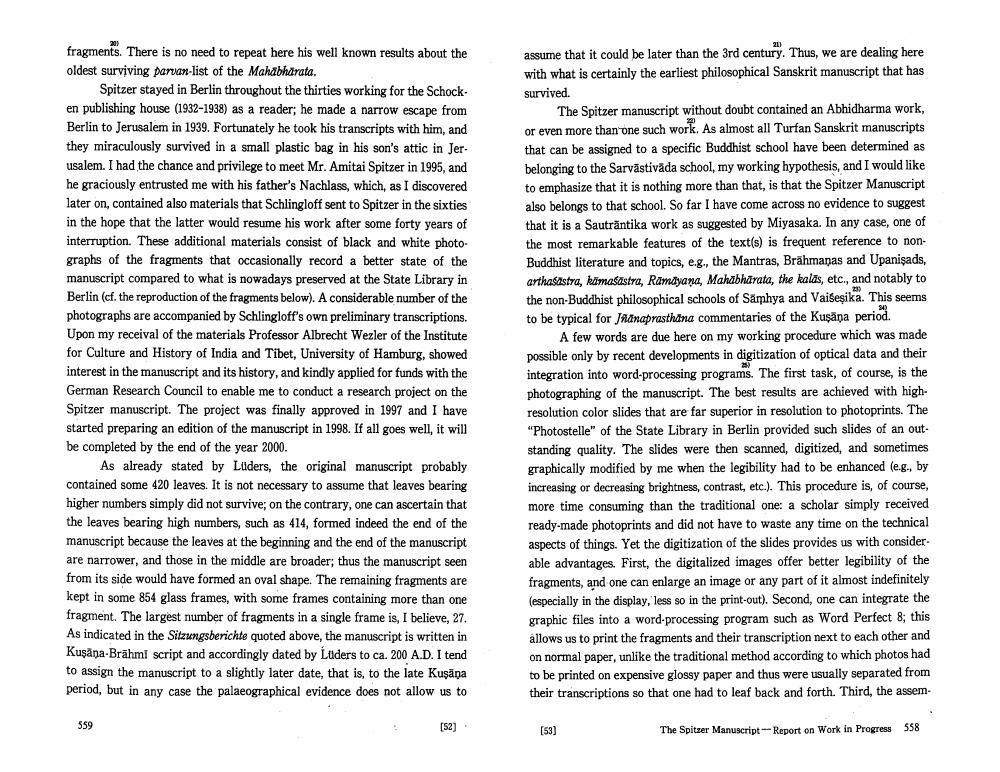Book Title: Spitzer Manuscript Report On Work In Progress Author(s): Eli Franco Publisher: Eli Franco View full book textPage 3
________________ fragments. There is no need to repeat here his well known results about the oldest surviving parvan-list of the Mahabharata. Spitzer stayed in Berlin throughout the thirties working for the Schock. en publishing house (1932-1938) as a reader; he made a narrow escape from Berlin to Jerusalem in 1939. Fortunately he took his transcripts with him, and they miraculously survived in a small plastic bag in his son's attic in Jerusalem. I had the chance and privilege to meet Mr. Amitai Spitzer in 1995, and he graciously entrusted me with his father's Nachlass, which, as I discovered later on, contained also materials that Schlingloff sent to Spitzer in the sixties in the hope that the latter would resume his work after some forty years of interruption. These additional materials consist of black and white photographs of the fragments that occasionally record a better state of the manuscript compared to what is nowadays preserved at the State Library in Berlin (cf. the reproduction of the fragments below). A considerable number of the photographs are accompanied by Schlingloff's own preliminary transcriptions. Upon my receival of the materials Professor Albrecht Wezler of the Institute for Culture and History of India and Tibet, University of Hamburg, showed interest in the manuscript and its history, and kindly applied for funds with the German Research Council to enable me to conduct a research project on the Spitzer manuscript. The project was finally approved in 1997 and I have started preparing an edition of the manuscript in 1998. If all goes well, it will be completed by the end of the year 2000. As already stated by Lüders, the original manuscript probably contained some 420 leaves. It is not necessary to assume that leaves bearing higher numbers simply did not survive; on the contrary, one can ascertain that the leaves bearing high numbers, such as 414, formed indeed the end of the manuscript because the leaves at the beginning and the end of the manuscript are narrower, and those in the middle are broader; thus the manuscript seen from its side would have formed an oval shape. The remaining fragments are kept in some 854 glass frames, with some frames containing more than one fragment. The largest number of fragments in a single frame is, I believe, 27. As indicated in the Sitzungsberichte quoted above, the manuscript is written in Kuşaṇa-Brahmi script and accordingly dated by Luders to ca. 200 A.D. I tend to assign the manuscript to a slightly later date, that is, to the late Kuṣāņa period, but in any case the palaeographical evidence does not allow us to 559 [52] assume that it could be later than the 3rd century. Thus, we are dealing here with what is certainly the earliest philosophical Sanskrit manuscript that has survived. The Spitzer manuscript without doubt contained an Abhidharma work, or even more than one such work. As almost all Turfan Sanskrit manuscripts that can be assigned to a specific Buddhist school have been determined as belonging to the Sarvästiväda school, my working hypothesis, and I would like to emphasize that it is nothing more than that, is that the Spitzer Manuscript also belongs to that school. So far I have come across no evidence to suggest that it is a Sauträntika work as suggested by Miyasaka. In any case, one of the most remarkable features of the text(s) is frequent reference to nonBuddhist literature and topics, e.g., the Mantras, Brahmanas and Upanisads, arthasastra, kamasastra, Ramayana, Mahabharata, the kalas, etc., and notably to the non-Buddhist philosophical schools of Sämhya and Vaiseşika. This seems to be typical for Jaanaprasthana commentaries of the Kuşāņa period. A few words are due here on my working procedure which was made possible only by recent developments in digitization of optical data and their integration into word-processing programs. The first task, of course, is the photographing of the manuscript. The best results are achieved with highresolution color slides that are far superior in resolution to photoprints. The "Photostelle" of the State Library in Berlin provided such slides of an outstanding quality. The slides were then scanned, digitized, and sometimes graphically modified by me when the legibility had to be enhanced (e.g., by increasing or decreasing brightness, contrast, etc.). This procedure is, of course, more time consuming than the traditional one: a scholar simply received ready-made photoprints and did not have to waste any time on the technical aspects of things. Yet the digitization of the slides provides us with consider. able advantages. First, the digitalized images offer better legibility of the fragments, and one can enlarge an image or any part of it almost indefinitely (especially in the display, less so in the print-out). Second, one can integrate the graphic files into a word-processing program such as Word Perfect 8; this allows us to print the fragments and their transcription next to each other and on normal paper, unlike the traditional method according to which photos had to be printed on expensive glossy paper and thus were usually separated from their transcriptions so that one had to leaf back and forth. Third, the assem [53] The Spitzer Manuscript-Report on Work in Progress 558Page Navigation
1 2 3 4 5 6 7 8 9 10
